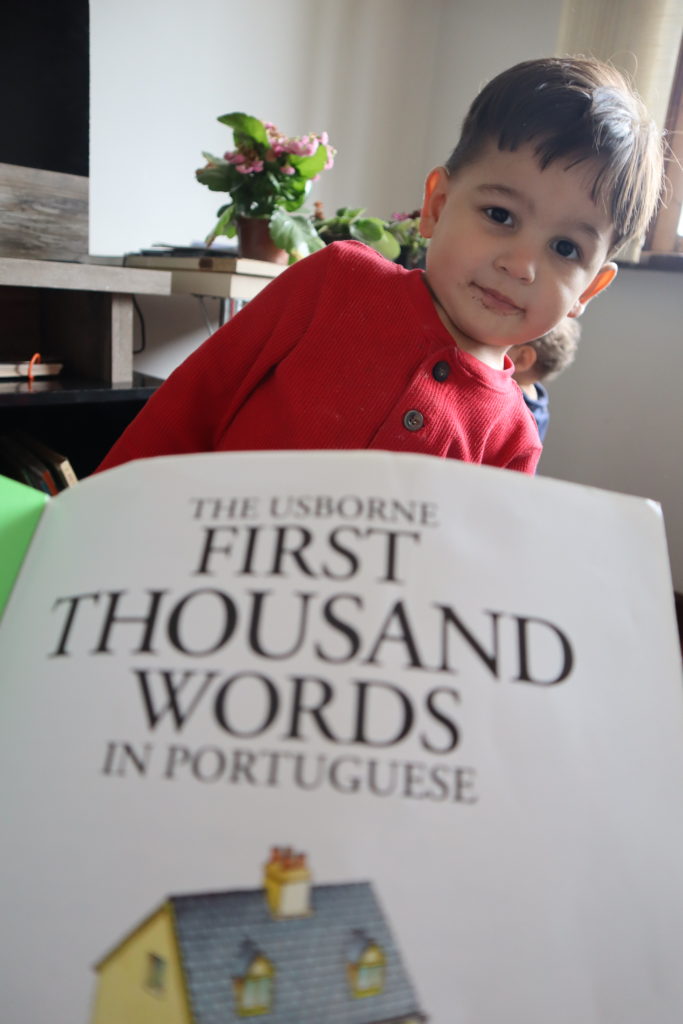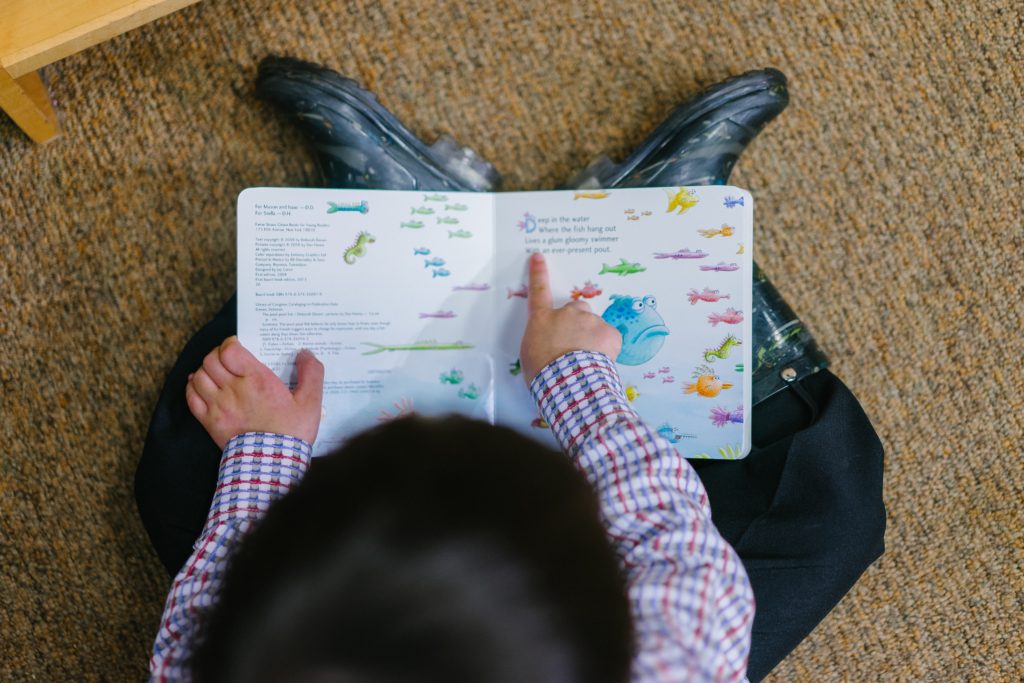Pre-Reading Literacy Strategies for Babies and Toddlers
Reading strategies you can use before, during, and after reading to enhance your child’s literacy–even if he is not yet able to read. These Pre-Reading Literacy Strategies for Babies and Toddlers help nurture a love for reading by deepening understanding and setting the stage for later literacy skills. They are simple, and anyone can use them.
Disclaimer: This post may contain affiliate links. As an Amazon associate, I earn from qualifying purchases, at no extra cost to you. Thank you for supporting the blog in this way!

What Is Pre-Reading?
The prefix “pre” means before. So can you guess what “pre-reading” means?
That’s right: the time before someone can read.
There is an assumption in this term: It assumes that the person in question will read someday.
What we all want is for our children to be great readers. (At least I do!) One day, they will read.
We can lay the groundwork for great reading skills even before our children know the alphabet.
How?
Let’s discuss!
What Are Pre-Reading Strategies?
The groundwork for great reading skills is laid through pre-reading strategies.
Pre-reading strategies help small children begin to understand the nature of literature and the written word. They identify and give names to the parts of a story, book, and reading experience.
These vocabulary words then become so useful in a child’s later understanding of how reading works.
Note that not all the pre-reading strategies have to feel uptight scholastic in nature. In fact, some of them we do as parents without even really consciously paying attention.
I don’t know how many parents I have seen ask questions about illustrations without thinking “I’m going to employ a pre-reading strategy!”
We can use these strategies very naturally and without thinking.
However, it is also important to use them consciously and to understand what we are doing so that we can help our children develop proper reading skills. If you–like me–want to create enthusiastic readers of your kids, these strategies can form a vital part in that process.

Reading Strategies for Babies and Toddlers
So without further ado, let’s get down to business. Here are several of the most helpful reading strategies that I try to use regularly with my own kiddos.
Pre-reading Literacy Strategies #1: Name the Title, Author, and Illustrator of a Book Before You Read It
It’s important for children to understand that someone wrote this story.
Before you read, then, make a point to read the information on the cover of the book (or at least on the title page): title, author, and illustrator.
You can also explain a little: “A title is the name of a book. An author writes. An illustrator draws pictures.”
Pre-reading Literacy Strategies #2: Delineate the Beginning, Middle, and End of the Story
This can help children recognize and internalize the idea that there is sequence to events and stories. In fact, a story can be divided into parts. And those parts have specific names.
As you start a book, you can say something simple like “This is the beginning of the story. What is this?” (pointing to the main character). As you finish, make a dramatic ending with “And that is THE END!”

Literacy Strategies #3: Identify the Main Character
Usually, the main character appears on the first page of a book–or near there. When you see the character, point back to the cover illustration (which likely also has the character). Point out that the images are the same.
Ask “Who/what is this?”
Then say something like “I wonder what he does. Let’s see!”
Quickly page through the book’s illustrations (without reading) and point to the main character on each page.
Then return to the beginning of the book and read the story.
Literacy Strategies #4: Point Out the Relationships Between the Characters
Most children love identifying families and relationships. After all, this is such an important part of their lives.
In books, identifying the relationships between the characters in the story can be an excellent activity for toddlers.
Bring the discussion of the text back to your child’s life by pointing out the relationships he has.
Ask questions like:
“Who is his mommy? Who is your mommy?”
“Who is with him in the picture? Who is with you now?”
Literacy Strategies #5: Identify Emotions of Characters
Being able to name and identify emotions is one key to nurturing empathy.
My eldest son showed me this very clearly. In one of our Portuguese-English vocabulary books that we read almost daily, he learned the names of some emotions, such as happy, sad, angry, shocked, surprised, and scared.
Awhile later, when we were reading another book, my son pointed to the tears on a character’s face. His little eyes instantly bunched up and he made a crying sound. I asked him, “Is he happy?” And my son responded, “No, no, no.” The dismay in his voice at the character’s sadness was so real.
My son was not only able to identify the character’s unhappiness but also to display empathy for him.
On another occasion, my eldest son saw an ouchie in a picture and laid his hand on the ouchie to pray for it. (A way that we deal with boo-boos in our house.) His action showed that he understood that he should help someone who was feeling unwell.
Some simple questions you can ask to build understanding of emotions in stories:
“Does he/she feel _____?”
“How does he/she feel?”
“Oh! Look what happened!” and then make a face mimicking the character’s emotion. Ask your child to imitate the face too.
Literacy Strategies #6: Ask Questions about the Illustrations
I have read many books in my life, but children’s books are some of my favorite ever.
Why?
The stories are great.
The words are fun.
But mostly it is because of the illustrations.
Pictures enhance a story so much. They help us to imagine the storyline that much more vividly.
For small children, pictures
Sample questions to ask about the illustrations in a story:
“What color is this?”
“What animals do you see?”
“Are there people in this picture?”
“What are the people doing?”
“How many ___ are there?”

Pre-reading Literacy Strategies #7: Point Out Similarities Between the Book and Other Books
When my son and I read The Runaway Bunny together, we also pull out Margaret Wise Brown’s classic Goodnight Moon and point to the bunnies in each book.
And the picture book Sunshine and Snowballs has an illustration of lightning that reminds us of the lightning in Mr. Brown Can Moo, Can You? by Dr. Seuss. Boom! Boom! Boom!
Not only are making these intertextual connections (connections between books) fun, they also hammer in some important points:
Stories can have similarities.
Stories can remind us of experiences.
Stories can help us understand the world around us, other people, and other stories.
Some questions you can ask:
“What other book has this?”
“Oh! Do you know that from somewhere?”
“Where have we seen this before?”
“What other animal can do that?”
Pre-reading Literacy Strategies #8: Have Your Child Verbally Translate a Passage from the Story
If you child is bilingual or learning to two languages, ask them about the story in both languages. This is an excellent exercise in building understanding of communication. As they do this, kids must use the appropriate words and forms of expression in each language.
If the book is only in one of the child’s languages, ask questions in the other language.
For example:
“What is his name? Qual e nome dele?”
(for a book in English) “Qual core e esse leao?

Literacy Strategies #9: Ask Your Child to Retell the Story
Retelling is wonderful for any age. When we retell, we must summarize and pick out important details. This means we have to pay attention to the details.
Of course, small children are not the most skillful retailers or summarizers. (Sometimes their “summaries” can be longer than the book itself!)
But that’s exactly why it is important to practice this, even before children are able to read.
Give opportunities to retell the stories that you read together.
To provide support for the retelling, you can page through the book together again, using the illustrations as cues. “And then what happened?” is a great question for this.
Literacy Strategies #10: Identify the Feelings of Reading
When you finish a book, tell your child how much you enjoyed reading with him. Say something like, “That was so fun! I like reading with you!”
Then invite your child to share how they felt about the story. You can ask, “Did you like it or not like it? Were you happy or sad to read this book?”
Identifying your child’s response to books helps him or her understand that stories can move us emotionally and also impact us. We interact with the words–we do not just read them.
As we name emotional responses to a story, we also show our children that stories are enjoyable. Among other things, reading can bring joy, togetherness, and a feeling of satisfaction.

Pre-reading Literacy Strategies #11: Draw a Scene or Character from the Story
If your child is up to the task, have him/her draw a character or scene from the story. (Tracing from the page is fine too.)
They might identify a favorite character or favorite part of the story to draw, which will help them to connect with parts of the story.
Final Thoughts
Reading with children is so much fun!
And it’s so important, too. Even before children can read, they can develop literacy skills that will be a strong foundation for later reading.
Looking for great books to read? Check out Our Favorite Board Books.
Try these strategies and let me know in the comments below which one is your favorite!
Chat with you soon,







Yes! These are great tips. Discussing the story is our preschoolers favorite part! After we read a book a few times and it becomes predictable we like to spend time looking for clues in the pictures that help tell the story (ex. Madeline is sad! I can tell because she is crying! Why is she sad? She is sick!). Thank you!!